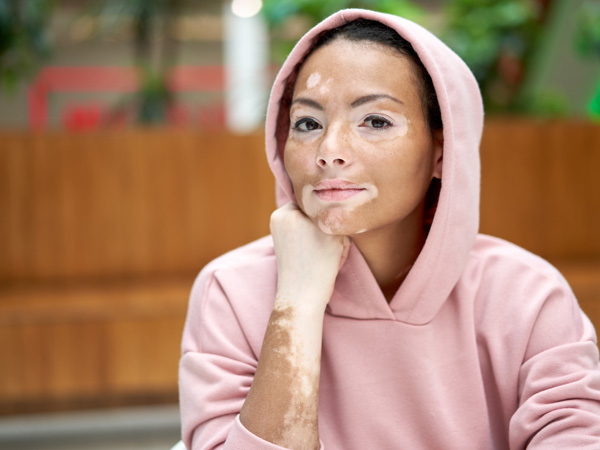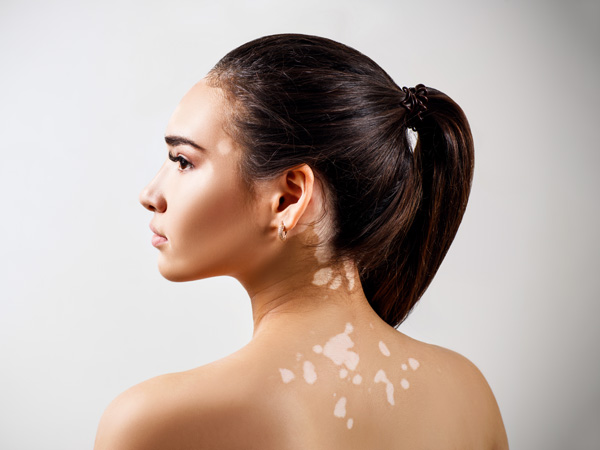- Home
- Science
- Diseases & Conditions
- Vitiligo
What Is Vitiligo?
Vitiligo is a condition in which some of the skin loses its pigmentation (color), causing patches of lighter skin to appear. The loss of pigmentation occurs when cells that produce pigment, called melanocytes, are destroyed.1
Primarily viewed as a skin condition, vitiligo can also affect hair, eyes, inner ear, and mucous membranes (inside the mouth and nose).1,2,3 It's often seen on the face, dorsal hands, or feet.2
Vitiligo Prevalence
Vitiligo affects about 1% of people in the world. People of every gender and skin color can develop vitiligo; however, the lighter patches it causes are often more noticeable on people with darker skin.2
Causes and Risk Factors
What Causes Vitiligo?
Vitiligo begins with the death of melanocytes, the cells responsible for giving your skin and hair their color. Researchers don't know exactly why this happens.2,3 The most common type of vitiligo, known as generalized or nonsegmental vitiligo, may be an autoimmune disorder in which the body's immune system attacks melanocytes and kills them.3,4 Alternatively, evidence suggests that segmental vitiligo, a type of the disease that differs from generalized vitiligo: it may have a different cause and could be related to the nervous system.4,5

Vitiligo Risk Factors
These factors can increase the risk of developing vitiligo:4
- Family history of vitiligo
- Family history of autoimmune conditions
- Melanoma or non-Hodgkin lymphoma
- Another autoimmune disorder
- Certain gene changes
Vitiligo Triggers
Vitiligo may flare or spread due to:4
- Stress
- Sunburn, cuts, or other skin damage
- Chemical exposure
Types of Vitiligo
The two types of vitiligo are generalized and segmental.4
Typically referred to as either generalized and nonsegmental vitiligo, this type of vitiligo is the most common. It causes white patches on both sides of the body—people with nonsegmental vitiligo may notice that patches appear on both hands, for example. The loss of color typically occurs rapidly and covers a large area of the body.1 Color loss is typically progressive, meaning it occurs more over a person’s lif etime. New patches may form and existing patches may expand over time.2,3
This less common type of vitiligo causes patches on one part of the body, such as the face or an arm or leg. It tends to appear at a younger age and continues for about one or two years before it stops.1 Some people with this condition also lose some hair color.6
The different subtypes of vitiligo help describe where depigmentation occurs and how much area it covers.7:
- Focal Vitiligo. The loss of pigmentation occurs in small patches. A doctor will confirm a focal vitiligo diagnosis if the loss of pigmentation hasn’t changed in one to two years.8
- Universal Vitiligo. In this type, at least 80% of the body's skin lacks pigmentation.9
- Mucosal Vitiligo. This type affects the mucous membranes, often in the mouth or the genitals.10,11
Conditions Commonly Mistaken for Vitiligo
- Tinea versicolor
Caused by yeast on the skin, this common condition appears as red, pink, or brown spots that, like vitiligo, can be lighter than the surrounding skin. Tinea versicolor spots may be scaly or itch, but vitiligo patches have the same skin texture as pigmented skin. With treatment, tinea versicolor can resolve, and the lighter patches of skin may eventually return to their original pigment.12,13
- Pityriasis alba
This common skin condition forms scaly red patches on the skin. When the patches resolve, they leave behind lighter-colored areas. This condition mostly affects children and may be related to atopic dermatitis. The scaly areas of skin typically heal on their own, and, unlike vitiligo, the lighter patches typically resolve by adulthood.14
- Piebaldism
This condition can look similar to vitiligo, but it stems from genetic mutations and is usually present from birth. People with piebaldism have an absence of melanocytes, usually in areas along a front hairline, causing unpigmented patches of skin. These patches can appear in different areas of the body and on both sides of the body. A white section of hair at the foreline is reported in 90% of those with this condition.15
- Hypopigmentation
This general term refers to any decrease in skin pigmentation. It is a symptom of many different skin disorders, including vitiligo.16
- Albinism
People with albinism produce less melanin, leading to lighter skin, hair, and eyes. Unlike with vitiligo, this inherited condition leads to a loss of pigmentation throughout the body rather than in patches.17
- Leucoderma or Leukoderma
Being exposed to industrial chemicals can damage skin cells, causing light patches of skin that look similar to vitiligo. Unlike vitiligo, chemical leukoderma is not caused only by gene or immune system changes.7,18
Vitiligo Symptoms
The primary symptom of vitiligo is skin depigmentation, or loss of color. Affected skin may become lighter than the surrounding skin or turn white. Depigmentation often occurs on the face, hands, and feet, but lighter areas can occur anywhere on the body, including the hair, on the genitals, and inside the nose or mouth. Symptoms usually appear before age 20.1,4
Some people with vitiligo may also experience1,19:
- Inflammation or swelling of the eye (uveitis)
- Hearing loss

Vitiligo Complications
Some people with vitiligo may be more likely to have or develop other autoimmune disorders, including:1
- Type 1 diabetes
- Addison's disease
- Psoriasis
- Rheumatoid arthritis
- Lupus
- Thyroid autoimmune disorders
- Pernicious anemia

Diagnosis and Treatment
Vitiligo Diagnosis
People usually receive a vitiligo diagnosis through a physical exam. Your doctor will ask about your family history and personal medical history. They may also want to perform a blood test to check your thyroid.20
Vitiligo Treatment
Not all treatments restore original skin color for all people. Treatments are meant to return pigment to some extent, slow the condition's progression, and make the skin look more even. Some people with vitiligo choose not to change the condition's appearance.20
- Topical Treatments for Vitiligo
A topical JAK inhibitor in the form of a medicated skin cream may restore pigment by inhibiting immune mechanisms and stopping melanocyte destruction.20,21 There are no other approved treatments for repigmenting vitiligo, although some doctors may prescribe other off-label medications, such as corticosteroids or calcineurin inhibitors.1,20
Makeup, self-tanner, or skin dyes may also minimize the appearance of vitiligo spots.20
- Phototherapy for Vitiligo
Phototherapy can help restore color to the skin.20 This therapy can be effective for many people but can take years to fully show results.20,22 Furthermore, combining phototherapy with vitamin D that’s applied to the skin may prevent the breakdown of melanocytes, which lead to vitiligo.23 Different types of phototherapy can help treat vitiligo:
- Narrowband UVB (nbUVB) light therapy. The most common treatment for nonsegmental (generalized) vitiligo, nbUVB outperforms other phototherapies in producing repigmentation with stronger color match. Nursing persons,birthing perso ns, and children may undergo this treatment, as it has fewer side effects than other options.22
- Excimer laser. Using a similar wavelength of narrowband UVB light, this laser encourages the body to restore skin color. This treatment works best for small areas of skin.2,20
- UVA light with psoralen (PUVA). Psoralen, a compound that helps the body absorb UV light, can be applied to the skin or taken orally to treat widespread vitiligo. This treatment is applied at a hospital or other facility. PUVA does not work well on the hands or feet.2,24
- UV light. Sitting in front of a light box can treat large areas of skin. This type of therapy is most effective on the face.20
- Depigmentation Treatment for Vitiligo
A less common treatment, depigmentation, involves removing the rest of the pigment from the skin. This approach leaves a person with a more even, but entirely lighter, skin tone. Treatment involves applying a cream to the skin regularly. Removing pigment may take up to four years.20
- Surgery for Vitiligo
Surgery can be an option for vitiligo that doesn’t respond to other treatments. In surgical treatment, pigmented skin from another part of the body is grafted (attached) to the vitiligo-affected skin.1
Living With Vitiligo
Certain triggers can cause vitiligo to spread. Understanding these triggers and avoiding them can limit vitiligo’s progress. For example, depigmented patches may be more sensitive to sunlight, making UV protection important.2,4
Some people may forego treatment but cover the vitiligo patches with makeup.20
Finding support is important. For some, vitiligo can cause feelings of depression, embarrassment, or uncertainty. Reaching out to friends, family, support groups, or a therapist could help.3,4,25
Global Impact of Vitiligo
Vitiligo affects about 1% of the world's population, although some researchers estimate that figure could be as high as 1.5%.26 Globally, that equates to about 70 million people with vitiligo.27
Vitiligo can be psychologically challenging for people who have it, and there is still limited research into causes of vitiligo and treatments.27 People may face stigma because of their skin depigmentation.28
Most people with vitiligo appear otherwise healthy. As a result, some may view the condition as simply cosmetic. However, people with vitiligo can develop other autoimmune conditions that don't just affect the skin and which require treatment.2 Misconceptions about the nature of vitiligo create limitations in accessing care and insurance coverage for treatment.26,28

Frequently Asked Questions About Vitiligo
- Is vitiligo contagious?
No. Vitiligo is an autoimmune condition and is not contagious.1,27
- Is vitiligo genetic?
About 20% of people with vitiligo have a close relative with the condition, and researchers have discovered more than 30 genes associated with an increased risk for vitiligo. However, the full cause of vitiligo is still unknown. It may be a combination of genes and environmental factors such as stress, exposure to UV light, and exposure to chemicals.26
- How do you prevent vitiligo?
Vitiligo cannot be prevented, in part because there's a limited understanding of what causes the condition. Sun damage can affect the appearance of vitiligo or cause more patches.2,4
- Is vitiligo an autoimmune disease?
Yes. Nonsegmental or generalized vitiligo, the most common type, is thought to be an autoimmune disorder. The immune system attacks the melanocytes, or pigment cells, in the skin. Approximately 15% to 25% of people who live with vitiligo also have another autoimmune disorder.26
- Is there a cure for vitiligo?
No. Currently there is no cure for vitiligo, although treatment is available. Existing treatments largely focus on camouflaging lighter patches of skin, recovering skin pigmentation, or learning to accept and live with the skin condition.2
Learn More About Vitiligo
Find a Pfizer clinical trial for vitiligo at PfizerClinicalTrials.com.
Explore vitiligo clinical trials at ClinicalTrials.gov.
Area of Focus: Inflammation & Immunology
Vitiligo is a focus of Pfizer’s Inflammation & Immunology Therapeutic Area. Visit the Inflammation & Immunology Page.
- References
- Overview of vitiligo. National Institute of Arthritis and Musculoskeletal and Skin Diseases. Accessed February 14, 2022. https://www.niams.nih.gov/health-topics/vitiligo.
- Vitiligo. American Osteopathic College of Dermatology. Accessed February 14, 2022. https://www.aocd.org/page/Vitiligo.
- Vitiligo: Who gets and causes. American Academy of Dermatology Association. Accessed February 15, 2022. https://www.aad.org/public/diseases/a-z/vitiligo-causes.
- Vitiligo overview. National Health Service. Accessed February 15, 2022. https://www.nhs.uk/conditions/vitiligo/.
- van Geel N, Mollet I, Brochez L, et al. New insights in segmental vitiligo: case report and review of theories: Segmental vitiligo: new insights. British Journal of Dermatology. 2012;166(2):240-246.
- Lee DY, Kim CR, Park JH, Lee JH. The incidence of leukotrichia in segmental vitiligo: implication of poor response to medical treatment: The incidence of leukotrichia in segmental vitiligo. International Journal of Dermatology. 2011;50(8):925-927.7.
- Ezzedine K, Lim HW, Suzuki T, et al. Revised classification/nomenclature of vitiligo and related issues: the vitiligo global issues consensus conference: vitiligo global issues consensus conference. Pigment Cell & Melanoma Research. 2012;25(3):E1-E13.
- Lommerts JE, Schilder Y, de Rie MA, Wolkerstorfer A, Bekkenk MW. Focal vitiligo: long-term follow-up of 52 cases. J Eur Acad Dermatol Venereol. 2016;30(9):1550-1554
- Linthorst Homan MW, A. G. Sprangers M, de Korte J, Bos JD, van der Veen JPW. Characteristics of patients with universal vitiligo and health-related quality of life. Arch Dermatol. 2008;144(8).
- Nagarajan A, Masthan M, Sankar L, Narayanasamy A, Elumalai R. Oral manifestations of vitiligo. Indian J Dermatol. 2015;60(1):103.
- Mulekar SV, Al Issa A, Al Eisa A. Treatment of vitiligo on difficult-to-treat sites using autologous noncultured cellular grafting. Dermatologic Surgery. 2009;35(1):66-71.
- Vitiligo: signs and symptoms. American Academy of Dermatology Association. Accessed February 14, 2022. https://www.aad.org/public/diseases/a-z/vitiligo-symptoms.
- Tinea versicolor: signs and symptoms. American Academy of Dermatology. Accessed February 14, 2022. https://www.aad.org/public/diseases/a-z/tinea-versicolor-overview.
- Pityriasis alba. American Osteopathic College of Dermatology. Accessed February 14, 2022. https://www.aocd.org/page/PityriasisAlba.
- Piebaldism. MedlinePlus. Accessed February 14, 2022. https://medlineplus.gov/genetics/condition/piebaldism/#causes.
- Roh MR, Oh SH. Acquired hypopigmentation disorders other than vitiligo. UpToDate. Accessed February 14, 2022. https://www.uptodate.com/contents/acquired-hypopigmentation-disorders-other-than-vitiligo.
- Albinism. MedlinePlus. Accessed September 12, 2022. https://medlineplus.gov/ency/article/001479.htm.
- Ghosh S. Chemical Vitiligo: A subset of vitiligo. Indian J Dermatol. 2020;65(6):443-449. doi:10.4103/ijd.IJD_291_20. https://pubmed.ncbi.nlm.nih.gov/33487697/.
- de Jong MA, Adelman C, Gross M. Hearing loss in vitiligo: current concepts and review. Eur Arch Otorhinolaryngol. 2017;274(6):2367-2372. doi:10.1007/s00405-017-4452-8
- Vitiligo: diagnosis and treatment. American Academy of Dermatology Association. Accessed February 15, 2022. https://www.aad.org/public/diseases/a-z/vitiligo-treatment.
- FDA approves topical treatment addressing repigmentation in vitiligo in patients aged 12 and older. https://www.fda.gov/drugs/news-events-human-drugs/fda-approves-topical-treatment-addressing-repigmentation-vitiligo-patients-aged-12-and-older. Updated July 19,2022. Accessed August 11, 2022.
- Treatment Guidelines: Second-line Treatments: Medicines and Light Combinations. VR Foundation. Accessed May 26, 2022. https://vrfoundation.org/treatment_guidelines
- AlGhamdi K, Kumar A, Moussa N. The role of vitamin D in melanogenesis with an emphasis on vitiligo. Indian J Dermatol Venereol Leprol. 2013;79(6):750.
- Phototherapy: PUVA. American Osteopathic College of Dermatology. Accessed September 12, 2022. https://www.aocd.org/page/PhototherapyPUVA.
- Vitiligo: Self-care. American Academy of Dermatology Association. Updated June 29, 2022. Accessed September 12, 2022. https://www.aad.org/public/diseases/a-z/vitiligo-self-care.
- Vitiligo. MedlinePlus. Accessed February 15, 2022. https://medlineplus.gov/genetics/condition/vitiligo/.
- Vitiligo facts. Global Vitiligo Foundation. Accessed February 15, 2022. https://globalvitiligofoundation.org/vitiligo-facts/.
- Harris J. Vitiligo's impact is in the eye of the beholder. Nature. Published November 21, 2018. Accessed February 15, 2022. https://www.nature.com/articles/d41586-018-07435-5.
The information contained on this page is provided for your general information only. It is not intended as a substitute for seeking medical advice from a healthcare provider. Pfizer is not in the business of providing medical advice and does not engage in the practice of medicine. Pfizer under no circumstances recommends particular treatments for specific individuals and in all cases recommends consulting a physician or healthcare center before pursuing any course of treatment.


